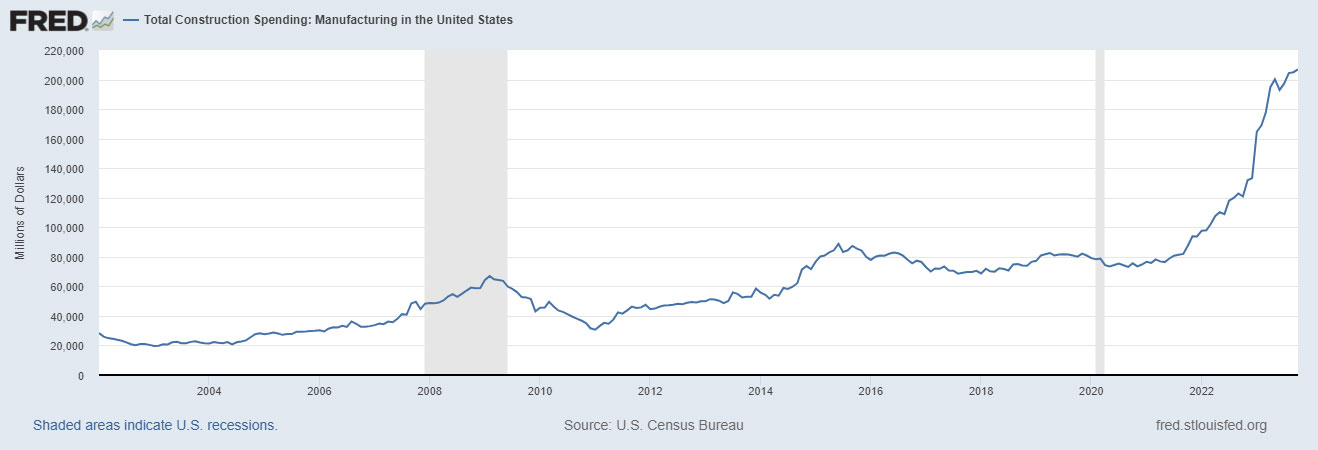
An American manufacturing renaissance may be in the works
More factory jobs may appear as some service jobs decline
For generations, American manufacturing had been a shrinking part of the economy—and American life. As more production moved overseas to countries like China, manufacturing jobs declined, and so did the cities where the former factories were located.
However, the tide seems to be turning.
From January 2002 to September 2023, spending on the construction of manufacturing facilities in the U.S. grew by more than 600%, according to data from the St. Louis Fed. Much of that growth has been since 2022 when manufacturing facility construction spending shot up.
This investment in U.S.-domiciled manufacturing facilities is part of ongoing deglobalization, experts believe. “American companies have been starting to re-shore and ‘friend-shore’ manufacturing,” said Matt Stephani, president of Cavanal Hill Investment Management, Inc. This trend includes not just manufacturing more on American soil, but also the U.S. importing more from Mexico than from China due to the current tariffs and restrictions on imports from China and less potential for supply chain disruptions.
Moving toward a divided world once again?
Meanwhile, the current geopolitical environment makes it riskier for companies to have production overseas, also driving the needle toward a less global economy.
“We’ve seen Russia invade Ukraine, Russia and China declare their 100-year friendship, and now what’s happening with Israel and Hamas,” said Steve Wyett, BOK Financial® chief investment strategist. “Then, there’s always the Damocles sword of China and how they view Taiwan. The bottom line is that the geopolitical environment has not gotten any calmer over the last 12 months. If anything, it is probably less stable and, in that environment, we’re going to continue to see a move towards deglobalization and different trade agreements come up.”
One way to think of it is as a quasi-return to the geopolitical environment of the Cold War. At that time, the divide was between the U.S. and the Soviet Union and each nation’s allies.
However, in 1989, the fall of the Berlin Wall and subsequent collapse of the Soviet Union began the process of globalization. As the world moved away from the division between East and West, Communist and non-Communist countries, trust grew between nations and led to what Stephani calls a “peace dividend.”
This dividend grew further when China entered the World Trade Organization in 2001, which enabled U.S. companies to offshore more jobs to Asia, including China. In other words, one consequence of globalization was the movement of some manufacturing—and jobs—away from the U.S. to places where companies could secure labor more cheaply.
But now the world is becoming more divided once again, and this time the split is between the U.S. and its allies and China and its allies, Stephani said.
And that renewed bifurcation is changing some ways U.S. companies do business. Here’s why.
Offshore labor becoming costlier—and riskier
For most of the past 20 years, the difference for U.S. companies between paying for offshore labor in China and paying for labor in the United States was “so wide that you could accept other risks to your business and still do better because you were paying so much less for labor,” Wyett said.
However, since 2018, that difference in labor costs has been shrinking, while the level of risk has been increasing, he explained. One contributing factor has been the growth of China’s middle class, which has been driving up the cost of labor there. Then, supply chain disruptions caused by the COVID-19 pandemic raised the production and distribution risks of U.S. companies who make their products in China, Wyett explained. That further eroded the advantages of lower labor costs there.
“COVID started breaking the peace dividend that we’ve had for 30 years,” Stephani said, noting that the economic strain caused by supply chain disruptions increased the political strain between Eastern nations like China and Western nations like the U.S.
“Then, the Olympics solidified it,” he continued. “When [China’s] President Xi and [Russia’s] President Putin stood onstage together at the Olympics and talked about increased cooperation before the invasion of Ukraine, that set the stage for a multipolar world stage rather than a global structure built around organizations such as the UN.”
U.S. job market may change
Altogether, the fact that it’s becoming less cost-efficient and riskier to manufacture goods overseas is one reason we’re seeing such a sharp increase in the construction of manufacturing facilities in the U.S., experts said.
On the downside, this less efficient global economy could mean that the prices of goods will increase because manufacturing them will be more expensive, Wyett said.
However, on the plus side, more manufacturing facilities in the U.S. also likely means more manufacturing jobs, he noted. This increase in manufacturing job openings could exacerbate the already-tight labor market, or it might be offset by a reduced number of service-oriented, minimum-wage jobs. Wyett foresees those jobs—such as working at fast food counters—decreasing because of the increased use of self-service kiosks, automation and higher minimum wage laws set by some states.
This resurgence in American manufacturing, combined with greater use of technology, means that while some types of jobs will become nearly obsolete in the years ahead, that doesn’t mean there will be fewer jobs overall, Wyett explained.
“Before, the fear was that technology puts more people out of work than it puts to work. But the U.S. labor force is much larger now than it was 20 years ago, even though we’re using a lot more technology, so people’s jobs have changed. Every one of us is doing our job differently today than we did 10 or 15 years ago.”
And so, while it may be less common for future teenagers to spend their summers working at a fast-food restaurant, they may be working manufacturing jobs that weren’t in the U.S. a decade ago.
2024 Annual Outlook
BOK Financial investment experts provide their outlook on key issues expected to affect the economy and financial markets for the year ahead.

